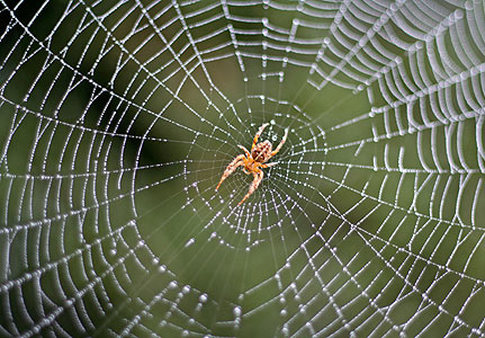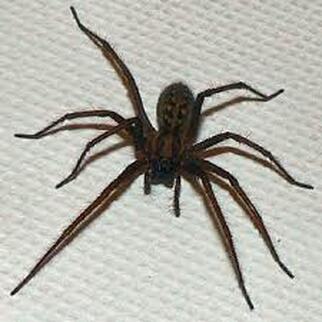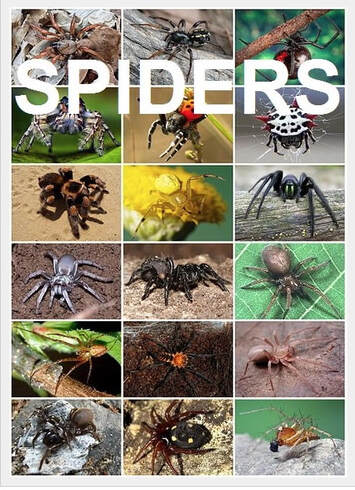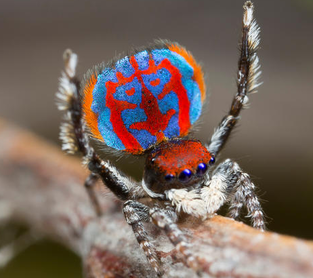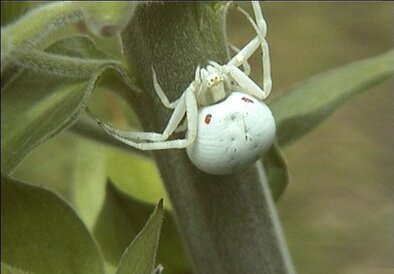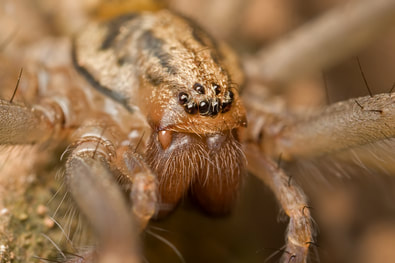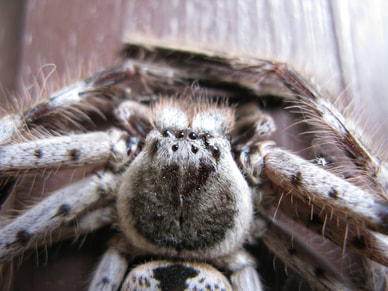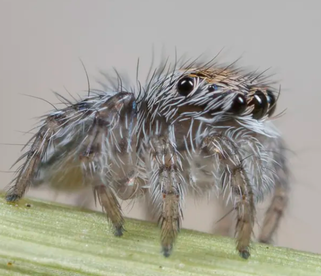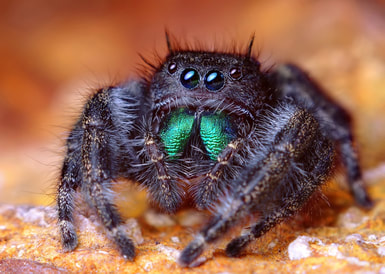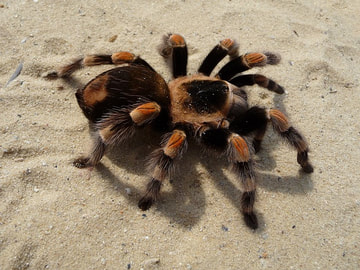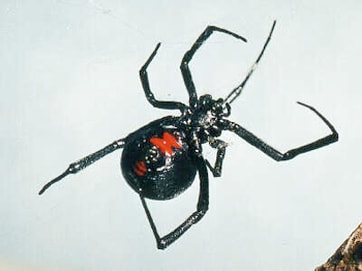SPIDERS
Arachnid - Invertebrate - Carnivore
Arachnid - Invertebrate - Carnivore
|
Male: Spider
|
Female: Spider
|
Young: Spiderling
|
- There are about 40,000 species of Spiders.
- Arachnophobia is the fear of Spiders.
Selection of Spider types:
|
Crab Spiders
Funnel-Web Spiders Jumping Spiders Trap-Door Spiders Nursery Web Spiders Peacock Spiders |
Orb Spiders
Spitting Spiders Wolf Spiders Pink Prowler Spiders Missing Sector Orb Spiders |
SPIDERS
Appearance:
Webs
Jumping Spiders
Raft Spiders
The Golden Wheel Spider
The Most Poisonous
The Most Aggressive Spider
The Smallest Spider
The Largest Spider
The Fastest Spider
The Most Deadly Spiders
The Most Feared Spider
The Oldest Spider
The Peacock Spider
Tarantulas
- Are classified as invertebrates. They don't have a backbone.
- Shed their skin.
- Its blood is pale blue.
- Are found on every Continent of the world - except Antarctica.
- Not all spider bites are deadly.
- Female spiders have a large appetite.
- Spiders eat more insects than birds and bats combined.
- Some spiders eat insects, other large ones eat birds and lizards.
- On average, there are 50,000 spiders per acre in green areas.
- Male spiders like to give gifts of flies and other insects, often wrapped in silk, to serenade prospective partners.
- Cover their eggs under silk to protect them.
- They inject a substance into their prey to dissolve its insides. Then they suck the liquid through a feeding tube.
- Some female spiders eat their mate.
- Some spiders have never been outside. In fact, for many, there is little chance of survival outside.
- The average house has about 30 spiders.
- The average life span for a spider is 1-2 years. Although the female Tarantula may live up to 20 years.
- Can lay as many as 3,000 eggs at one time. The Wolf Spider carries its young on its back
- Moults about 10 times through its life.
- Black Lace Weaver Spiders devour their mothers after hatching.
- A single strand of spider silk is thinner than a human hair, but five times stronger than steel of the same width.
- A fear of spiders is called 'arachnophobia'.
Appearance:
- Spiders have 8 legs - when they move, there are always 4 of the 8 legs on the surface.
- There are no muscles in their limbs, they move using hydraulic power.
- Have no antenna - which separates them from insects.
- Are near-sighted.
- Has four sets of eyes. Arrangement of the eyes depends upon the species.
- Do not have teeth.
- Have short hairs on their feet to help them walk upside dow on ceilings and over glass.
- The hairs on the spider's legs (first pair of legs) are sensitive to taste. The spider 'tastes' its prey by touching it.
- Have no bones. It has an exoskeleton - a hard suit of armour that protects the body.
Webs
- Not all spiders spin webs - some wait for their prey to approach them or they hunt and catch it.
- The spider's silk is extremely strong. It is considered to be five times stronger than a strand of steel that is the same thickness.
- When a spider is going to make a new web, it rolls the old one up into a ball, and some species will eat it.
- The web is liquid until it comes into contact with the air.
- There are 7 different types of silk. Some silk has special glue to make it sticky to catch insects. Other silk is not sticky.
- On average, it takes a spider about 1 hour to spin a web.
- Abandoned spiders' webs are called 'cobwebs'.
- Hummingbirds use small sticks and the silk from a spider's web to weave a nest for themselves.
- Cannot fly, but sometimes they sail through the air on a line of silk - known as 'ballooning'.
- The silk contained Vitamin K, which helps to prevent bleeding and, in the past, people put the webs on their wounds to help stop bleeding.
- A strand of spider silk long enough to encircle the Earth would only weigh just over a pound.
Jumping Spiders
- Can jump 50 times their own length.
- Have good eyesight.
- Two kinds of Jumping Spiders have been found at 23,000ft.
Raft Spiders
- Live on or in water.
- Can run across the water's surface.
The Golden Wheel Spider
- A huntsman spider native to the Namib Desert of Southern Africa.
- Escapes from danger by flipping onto its side and cartwheeling down the sand dunes
- Can move at speeds up to 44 turns per second.
- Buries itself into a silk-lined burrow.
- Very vulnerable to the Pompilid Wasp which will sting and paralyse the spider before planting eggs into its body.
The Most Poisonous
- The Brazilian Wandering Spider (also known as the Banana Spider) is the most poisonous.
- A small amount of venom will kill a human.
The Most Aggressive Spider
- The Funnel Web Spider
The Smallest Spider
- The Patu Marplesi Spider of Colombia
The Largest Spider
- The Giant Bird Eating Spider and the Huntsman Spider
- The Huntsman Spider has a leg-span of around 30cm (12 inches).
The Fastest Spider
- The Wolf Spider can run at speeds of up to 2 feet per second.
The Most Deadly Spiders
- Black Widow Spiders - the bite of the female is dangerous. She needs only to mate once and can then produce eggs for the rest of her life (about 2 years).
- The female Black Widow Spider's venom is 15 times more powerful than the poison of a rattlesnake.
- Black Widow Spiders feed their young liquid from their mouth.
- Funnel Web Spiders
- Brown Recluse Spiders
- Cats and horses are highly susceptible to Black Widow venom - dogs are relatively resistant and sheep and rabbits are apparently immune.
The Most Feared Spider
- The Tarantula - but it has a surprisingly weak venom and it's bite is like a wasp sing.
The Oldest Spider
- A female Trapdoor Spider, living in Australia, is believed to have been the oldest living Spider - 43 years. It is thought that she died from a wasp sting.
The Peacock Spider
- Found in Australia.
- Have a wonderful courtship dance - unique to each male. During the dance, the male will pause and drum on the ground - even on the head of the female, at times. The drumbeat vibrates across the ground and up the female's legs, which she finds irresistible.
- During the courtship, the male fans out his rear end, resembling a peacock, and showing off his stunning colours.
- Are venomous to other creatures, but possibly not to humans.
Tarantulas
- Large and often hairy spiders.
- Generally, pose no threat to humans.
- The largest species is called the Goliath Birdeater.
Visit: Spider . COLLECTIVE NOUNS, SIMILES, IDIOMS, METAPHORS and EXPRESSIONS
